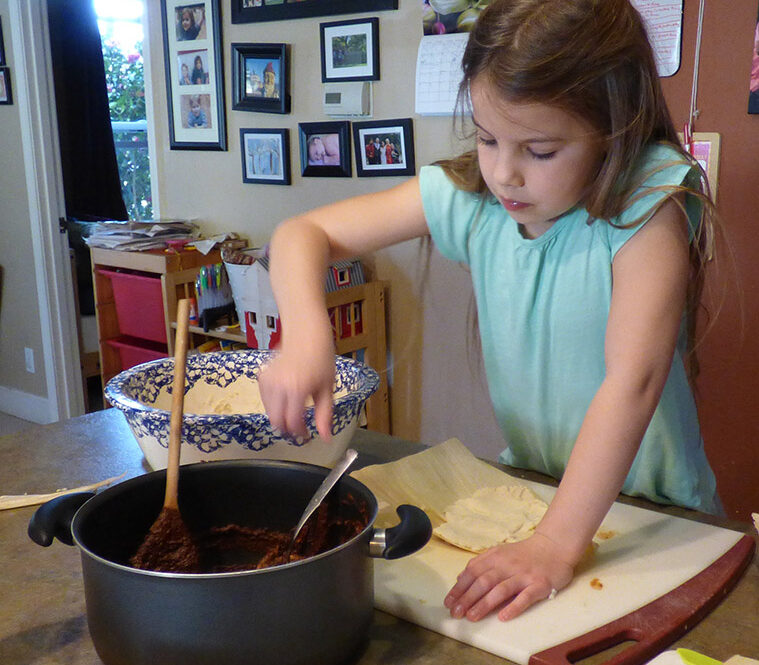When stay-at-home orders advised that people stock up in order to cut down on trips to the grocery store, I looked at my cupboards – rows of glass jars filled with dried beans, rice and lentils that my husband is always challenging me to get to the bottom of – and I smiled.
Why do I have all of this food amassed in my small house? Am I actually planning for the end of days? No. I simply grocery shop once each month. Actually, that’s not entirely accurate. I do the majority of our grocery shopping on one day each month and then I supplement it with smaller additions – milk, eggs and produce throughout the month. And I’ve done this for years – long before the coronavirus reared its ugly head.
Why do I do it? Torture myself for the majority of a day going from store to store when I could break it up, go once a week, or even once a day? There are several reasons. But the main one is this: when I shop less, I spend less. I don’t come out with those unplanned purchases. I find it easier to plan and budget – and with three hungry kids that is a major win.
Shop less, save more
Every time I walk into a store, I come out with something I did not intend to buy. It’s difficult not to. Stores are designed with just this ploy in mind. Eye-catching end caps and check-stand impulse purchases – these were all put there with the express purpose of adding one more thing to the cart. And I am no more immune to these tricks of the trade than anyone else. Instead, I live by the motto – the less I shop, the less I buy. Period.
While I have long labored under the illusion that limited grocery shopping is a trait only I possess, I recently found two like-minded, think-ahead menu-planning gurus – 33-year-old Brittany Stenger and 46-year-old Heather Shepherd.
“I’ve learned the hard way that without a plan, I will buy things on impulse that we really don’t need,” Stenger said, echoing my own reasoning. “There’s a lot of beautiful and alluring food packaging out there, and while I fully encourage everyone to treat themselves on something fun each week, it’s important to stay focused on your family’s goal with food and finances.”
Know before you go
Every good grocery list starts with a quick scan of the larder. What is there that needs to be used up? What should be thrown away? That’s where I begin.
“Before you head to the store, shop from your pantry first,” Stenger suggested. “Take inventory of what you already have and start there. How can you incorporate something that you already have in your pantry or freezer into a dinner or two this week?”
Once I have established what I already have, the month’s menu planning can begin. I use spiral notebooks for this part because they sit near my kitchen and are easy to reference throughout the day without turning on my computer. But my old-timey method isn’t for everyone and a simple Excel worksheet can work just as well.
“I use a weekly meal planning worksheet,” Shepherd said, “very simple, that shows the days of the week with an area for each meal.”
Keep the seasons in mind
After contemplating my cupboards, I consider what’s available, depending on the season. This is where notes of previous years’ menus can be helpful, but there are other research methods as well. Farm to fork websites and cookbooks focused on seasonal cooking are all a wealth of knowledge on what is fresh and locally sourced throughout the year. But the most helpful of all are farmer’s markets.
“Once I have gone to the farmer’s market, I will then plan my menus,” Shepherd, who does her meal planning on a weekly basis, said. “Having fresh vegetables for salads is amazing. I can cook ground beef to have taco salads or purchase lunch meat to make chef salads…alternating between the meals so my family does not become bored with the same food daily.”
Repetition simplifies planning
Morning and midday meals are easy at our house, because we rotate through a handful of favorites for breakfast and eat leftovers for lunch. Similarly, Stenger rotates two to three breakfasts and lunches throughout the week.
So, for my menu plan, I stick mainly to dinners. Using certain standbys – tacos, burritos and pizza – every month to simplify the planning. While Stenger uses a method of themed dinners that makes her own twice-monthly planning a breeze.
“We rotate two to three different breakfasts and lunches throughout the week,” she began. Adding, “We have ‘themed’ meals for dinner each week which has helped cut down on the decision fatigue that can come with poor meal planning. We incorporate one ‘take out’ (dine out, order in, order from a meal planning service, fast food, etc.) each week as well.”
With fun labels – Meaty Monday, Tired Tuesday, Thrifty Thursday and Sizzle Saturday – Stenger also, on occasion, adds in days to experiment with cooking something new, or making a double batch to freeze for later.
Budget and track
Keeping track of how much is spent on food each month – both at grocery stores and at restaurants – can highlight possible issues with overspending, wanton spending and wasted food.
“When I started budgeting for food, a few years ago, I realized how much food was being wasted because it was not being eaten before it went bad,” Shepherd admitted. “I also realized how much food just stayed on the shelf because I was taking my family out to eat meals.”
Also, estimating food spending each month can help you set and obtain goals.
“It’s wise to know where your money is going even if you aren’t facing financial difficulty or uncertainty,” Stenger said.
“Budgeting for food is helpful because you will feel less stressed if you have some sort of goal and plan set in place. Knowing where you stand will help you chart out where you want to go. It will also help you save for other expenses you might have coming up.”
But budgeting doesn’t mean giving up on foods that are wholesome or delicious. In fact, Shepherd has found that budgeting and menu planning have actually worked in tandem to help her ensure that her family is eating a healthy variety.
“When budgeting and meal planning together, you can ensure that you are feeding your family from all the food groups,” she stated. “I also started seeing how much processed foods my family ate and I started preparing more fresh items.”
The thing to keep in mind is that there is no right or wrong way to meal plan – once a week, every other week, or even once a month. And it can be a wholly new plan each time or it can be something that is reused week after week. The important thing to remember is that planning – though it may take work on the front end – eventually saves both time and money once the systems are in place.
“By researching what other families were doing, I noticed that the moms that were the least stressed out about cooking had some sort of system that they followed no matter how busy the days got,” Stenger said.
I whole-heartedly agree.



